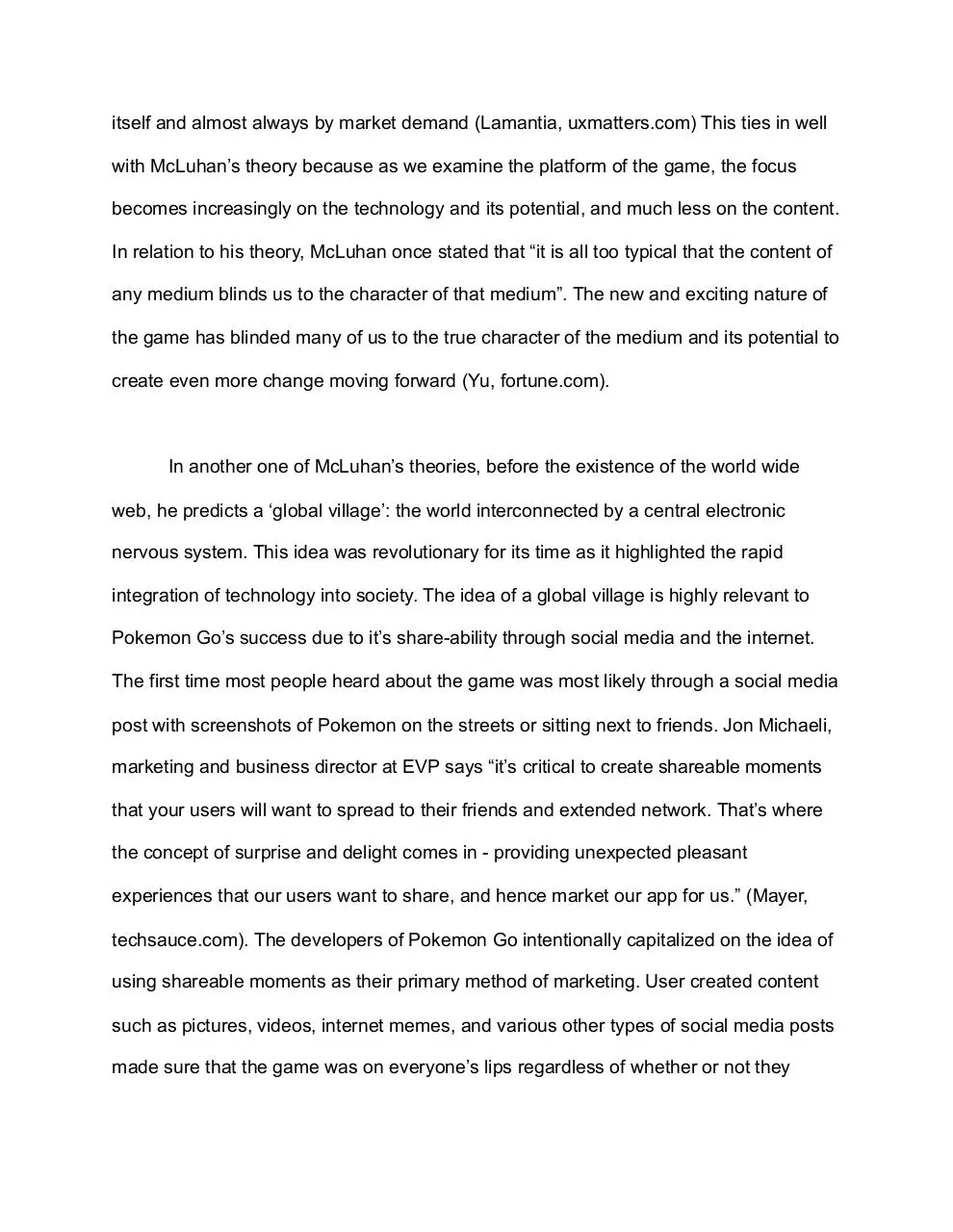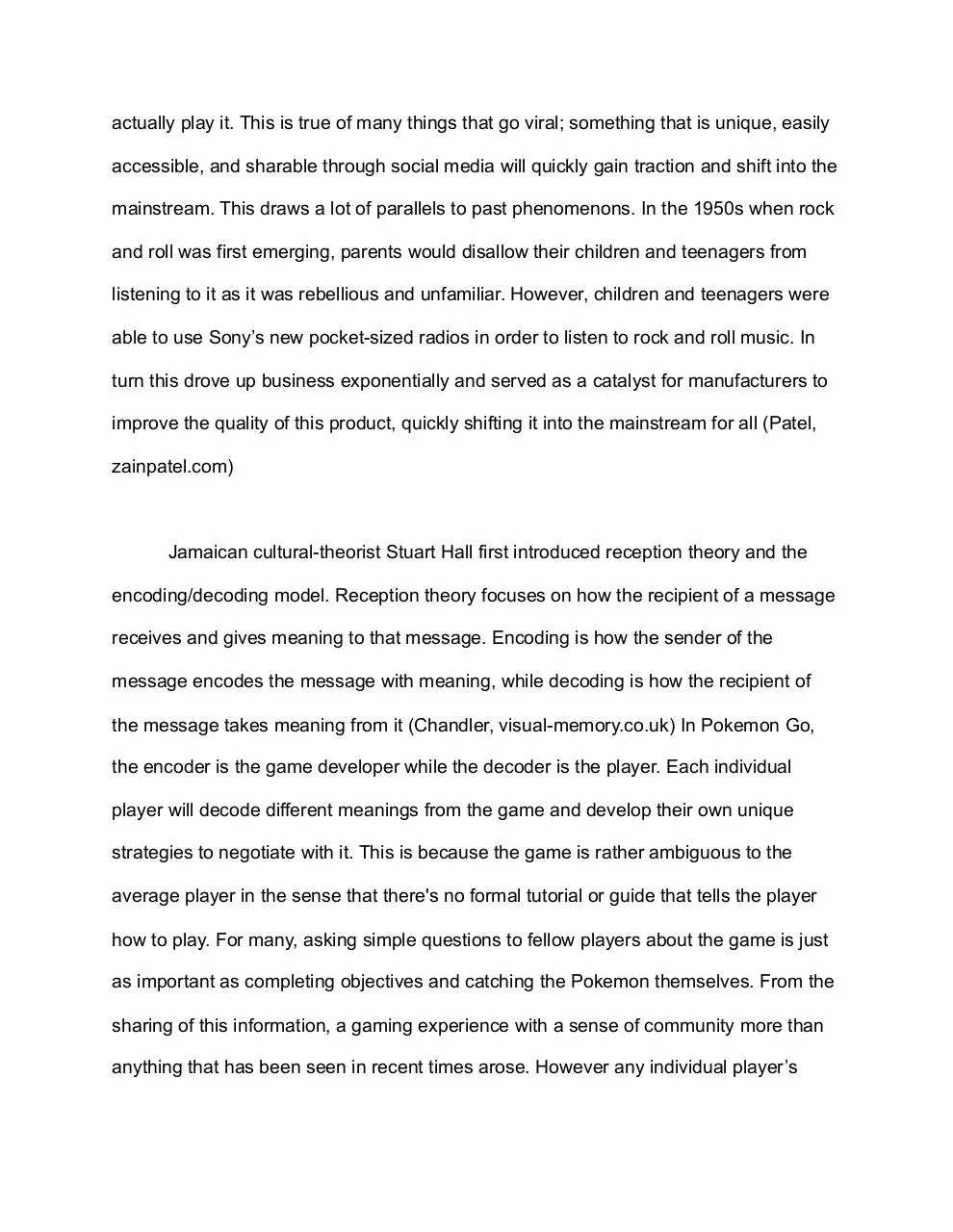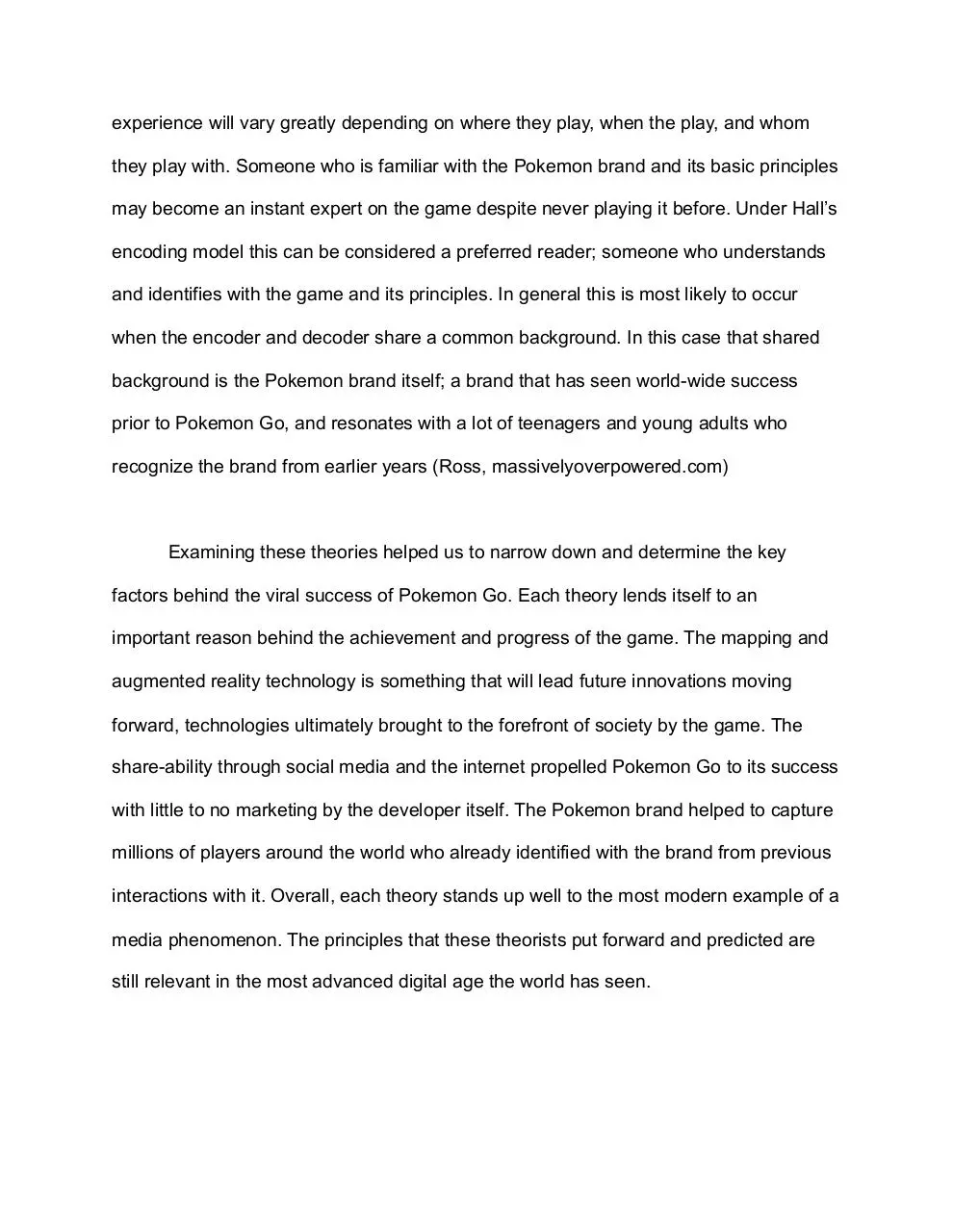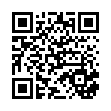RTA 101 Midterm Paper Analysis of Pokemon Go Final (1) (PDF)
File information
Title: RTA 101 Midterm Paper - Analysis of Pokemon Go
This PDF 1.3 document has been generated by Pages / Mac OS X 10.11.6 Quartz PDFContext, and has been sent on pdf-archive.com on 14/02/2017 at 02:03, from IP address 99.238.x.x.
The current document download page has been viewed 723 times.
File size: 68.54 KB (7 pages).
Privacy: public file





File preview
Michael Dyer
Student ID: #500714787
RTA101 / Section (111): Introduction to Media Theory
Midterm Paper - Analysis of Pokemon Go
The Pokemon Go phenomenon is one of the largest digital-cultural movements
seen since the beginning of the digital age, and the very existence of this smart phone
game is changing the way we interact and connect with one another on a number of
levels. The reasons behind its wild success and popularity can be examined under the
scope of media theory to help us determine why its become such a wide-scale,
revolutionary movement. Using popular media theories such as Marshall McLuhan’s the
medium is the message and the global village, as well as Stuart Hall’s model of
encoding/decoding, we can narrow and determine the major key factors behind the viral
success of Pokemon Go. When examining McLuhan’s theory that the medium is the
message we can begin to look past the content of the game itself and measure the
magnitude of the technology itself - the mapping and augmented reality engines that the
game uses are unique tools that have never seen such revolutionary use before. In
McLuhan’s theory of the global village, we can begin to examine how society’s
interconnectivity and heavy focus on social media and share-ability allowed the game to
flourish the way it has. Hall’s theory of encoding/decoding also helps us understand how
the players interact and decode meaning from the game itself. Players who are familiar
with the Pokemon brand will instantly identify with the game and its principles, and the
fact that the brand has already achieved world-wide success prior to Pokemon Go
greatly increases its popularity through its appeal to preferred readers.
Canadian professor and philosopher Marshall McLuhan first put forth the idea
that the ‘medium is the message’. Within the context of Pokemon Go, this is simply to
say that the platform and augmented reality technology has a much larger impact on the
fundamental nature of society than any message or content being delivered through the
game (Tremblay, 564). While the game itself is new and exciting, the primary focus
should be on the technology that makes the game possible. When we look at the scale
of Pokemon Go’s success, it seems as if overnight it took the world by storm. It
surpassed social media giants such as Twitter and Facebook in active users within a
few weeks of its release (Perez, techcrunch.com). The augmented reality technology
overlays the real world captured through the players camera with digitally generated
images that appear in specific or random locations. Even local businesses set up ‘lure
modules’, a purchasable in-game item that attracts Pokemon and monsters to the
location, which in turn attracts real life players looking to capture them and driving up
business. While the target demographic of the game is obviously teenagers and young
adults, it has irrevocably changed our social landscape as a whole. Instead of sitting
inside playing video games, players are forced out into the real world to explore,
socialize, and interact with others in order to meet in-game objectives. People of all
ages who would otherwise never be exposed to Pokemon and augmented reality now
see it on every media source around the world. This phenomenon can aggressively
push companies to of all brands to invest heavily in augmented reality technologies.
Perhaps in the future women who don’t have the patience to line up for a fitting room at
a clothing store can opt for an augmented reality fitting session. The possibilities for this
technology are endless, but improvement and innovation are rarely driven by science
itself and almost always by market demand (Lamantia, uxmatters.com) This ties in well
with McLuhan’s theory because as we examine the platform of the game, the focus
becomes increasingly on the technology and its potential, and much less on the content.
In relation to his theory, McLuhan once stated that “it is all too typical that the content of
any medium blinds us to the character of that medium”. The new and exciting nature of
the game has blinded many of us to the true character of the medium and its potential to
create even more change moving forward (Yu, fortune.com).
In another one of McLuhan’s theories, before the existence of the world wide
web, he predicts a ‘global village’: the world interconnected by a central electronic
nervous system. This idea was revolutionary for its time as it highlighted the rapid
integration of technology into society. The idea of a global village is highly relevant to
Pokemon Go’s success due to it’s share-ability through social media and the internet.
The first time most people heard about the game was most likely through a social media
post with screenshots of Pokemon on the streets or sitting next to friends. Jon Michaeli,
marketing and business director at EVP says “it’s critical to create shareable moments
that your users will want to spread to their friends and extended network. That’s where
the concept of surprise and delight comes in - providing unexpected pleasant
experiences that our users want to share, and hence market our app for us.” (Mayer,
techsauce.com). The developers of Pokemon Go intentionally capitalized on the idea of
using shareable moments as their primary method of marketing. User created content
such as pictures, videos, internet memes, and various other types of social media posts
made sure that the game was on everyone’s lips regardless of whether or not they
actually play it. This is true of many things that go viral; something that is unique, easily
accessible, and sharable through social media will quickly gain traction and shift into the
mainstream. This draws a lot of parallels to past phenomenons. In the 1950s when rock
and roll was first emerging, parents would disallow their children and teenagers from
listening to it as it was rebellious and unfamiliar. However, children and teenagers were
able to use Sony’s new pocket-sized radios in order to listen to rock and roll music. In
turn this drove up business exponentially and served as a catalyst for manufacturers to
improve the quality of this product, quickly shifting it into the mainstream for all (Patel,
zainpatel.com)
Jamaican cultural-theorist Stuart Hall first introduced reception theory and the
encoding/decoding model. Reception theory focuses on how the recipient of a message
receives and gives meaning to that message. Encoding is how the sender of the
message encodes the message with meaning, while decoding is how the recipient of
the message takes meaning from it (Chandler, visual-memory.co.uk) In Pokemon Go,
the encoder is the game developer while the decoder is the player. Each individual
player will decode different meanings from the game and develop their own unique
strategies to negotiate with it. This is because the game is rather ambiguous to the
average player in the sense that there's no formal tutorial or guide that tells the player
how to play. For many, asking simple questions to fellow players about the game is just
as important as completing objectives and catching the Pokemon themselves. From the
sharing of this information, a gaming experience with a sense of community more than
anything that has been seen in recent times arose. However any individual player’s
experience will vary greatly depending on where they play, when the play, and whom
they play with. Someone who is familiar with the Pokemon brand and its basic principles
may become an instant expert on the game despite never playing it before. Under Hall’s
encoding model this can be considered a preferred reader; someone who understands
and identifies with the game and its principles. In general this is most likely to occur
when the encoder and decoder share a common background. In this case that shared
background is the Pokemon brand itself; a brand that has seen world-wide success
prior to Pokemon Go, and resonates with a lot of teenagers and young adults who
recognize the brand from earlier years (Ross, massivelyoverpowered.com)
Examining these theories helped us to narrow down and determine the key
factors behind the viral success of Pokemon Go. Each theory lends itself to an
important reason behind the achievement and progress of the game. The mapping and
augmented reality technology is something that will lead future innovations moving
forward, technologies ultimately brought to the forefront of society by the game. The
share-ability through social media and the internet propelled Pokemon Go to its success
with little to no marketing by the developer itself. The Pokemon brand helped to capture
millions of players around the world who already identified with the brand from previous
interactions with it. Overall, each theory stands up well to the most modern example of a
media phenomenon. The principles that these theorists put forward and predicted are
still relevant in the most advanced digital age the world has seen.
Works Cited
Tremblay, Gaëtan. "From Marshall McLuhan to Harold Innis, or From the Global Village
to the World Empire." Canadian Journal of Communication. Université Du Québec à
Montréal, 4 Nov. 2012. Web. 26 Sept. 2016.
Perez, Sarah. "Pokémon Go Tops Twitter's Daily Users, Sees More Engagement
ThanFacebook." TechCrunch. N.p., 13 July 2016. Web. 24 Oct. 2016.
Lamantia, Joe. "Inside Out: Interaction Design for Augmented Reality." UXmatters. N.p.,
17 Aug. 2009. Web. 24 Oct. 2016.
Yu, Howard. "What Pokémon Go’s Success Means for the Future of Augmented
Reality." Fortune. N.p., 22 July 2016. Web. 24 Oct. 2016.
Mayer, Matt. "What Thai Startups Can Learn from Pokemon Go's Shareable Moments."
Tech Sauce. Thumbsup & Hubba, 18 Aug. 2016. Web. 24 Oct. 2016.
Patel, Zain. "McLuhan's Message." Zain Pattel. N.p., n.d. Web. 05 Oct. 2016.
Chandler, Daniel. "Semiotics for Beginners." Visual Memory. N.p., 7 Mar. 2014. Web. 24
Oct. 2016.
Ross, Andrew. "Comparing American and Japanese Pokemon Go Culture." Massively
Overpowered. N.p., 6 Sept. 2016. Web. 24 Oct. 2016.
Download RTA 101 Midterm Paper - Analysis of Pokemon Go Final (1)
RTA 101 Midterm Paper - Analysis of Pokemon Go Final (1).pdf (PDF, 68.54 KB)
Download PDF
Share this file on social networks
Link to this page
Permanent link
Use the permanent link to the download page to share your document on Facebook, Twitter, LinkedIn, or directly with a contact by e-Mail, Messenger, Whatsapp, Line..
Short link
Use the short link to share your document on Twitter or by text message (SMS)
HTML Code
Copy the following HTML code to share your document on a Website or Blog
QR Code to this page

This file has been shared publicly by a user of PDF Archive.
Document ID: 0000554531.